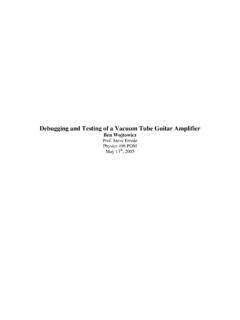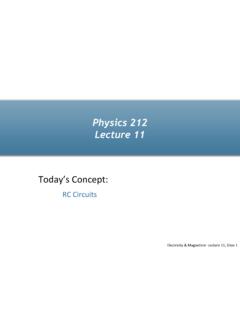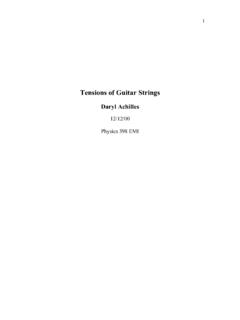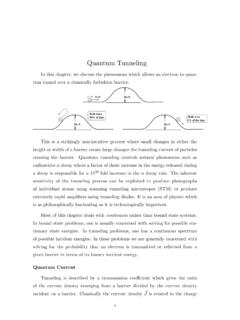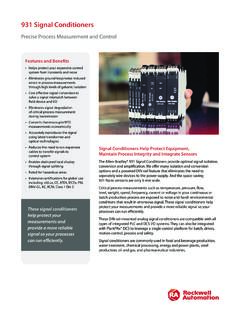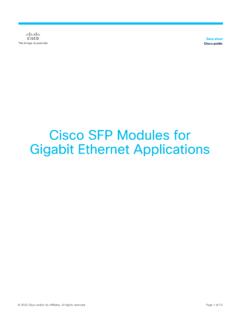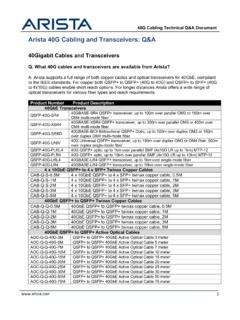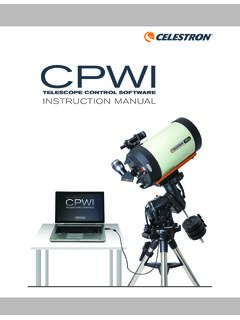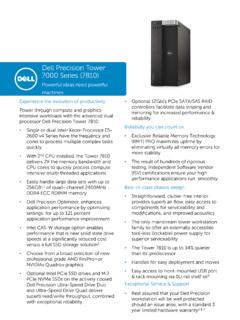Transcription of Lecture 5 - UIUC
1 Lecture 5, p 1 =2 = c0II0 Sum2I00 = c/3yyLecture 5:Applications of Interference and DiffractionLecture 5, p 2 TodayCircular Diffraction Angular resolution (Rayleigh s criterion) Minimum spot sizeInterferometers Michelson ApplicationsLecture 5, p 3 The size of the spot is determined by the diameter, D, of the aperture, and wavelength, , of the incident by a circular aperture is similar to single)slit diffraction. But note the difference:Image plane00II0 o DImage planePoint objecta Circular apertureThe Airy disk .The central lobe contains 84% of limited OpticsDiffraction has important implications for optical instrumentsEven for perfectly designed optics the image of a point source will be a little blurry ) the circular aperture produces diffraction.
2 Lecture 5, p 4 Slits and circular aperturesMonochromatic light source at a great distance, or a at any distance:Slit, width aLens, diameter DPinhole, diameter D ) /a 0 a0II0 ) /D 0 /D0II0 Observation screen:Image Plane:Observation screen:The focusing effect of the lens is independent of the diffraction effect due to the apertureLecture 5, p 5 Exercise: Expansion of a Laser beamDdIn 1985, a laser beam with a wavelength of = 500 nmwas fired from the earth and reflected off the space shuttle Discovery, in orbit at a distance of L = 350 kmaway from the the circular aperture of the laser was D = cm, what was the beam diameter dat the space shuttle?
3 Lecture 5, p 6 SolutionDdHalf)angle)width of diffraction maximum:952500 10 10oD === 53od 2 L 2( 10 )(350 10 m) m = =In 1985, a laser beam with a wavelength of = 500 nmwas fired from the earth and reflected off the space shuttle Discovery, in orbit at a distance of L = 350 kmaway from the the circular aperture of the laser was D = cm, what was the beam diameter dat the space shuttle? Lecture 5, p 7 Act 1 DdTo make a smaller spot on the shuttle, what should we do to the beam diameter at the source? be made smallerIn 1985, a laser beam with a wavelength of = 500 nmwas fired from the earth and reflected off the space shuttle Discovery, in orbit at a distance of L = 350 kmaway from the 5, p 8 SolutionDdTo make a smaller spot on the shuttle, what should we do to the beam diameter at the source?
4 Be made smallerCounter)intuitive as this is, it is correct you reduce beam divergence by using a bigger beam. (Note: this will work as long as D < d.)We ll see that this can be understood as a non)quantumversion of the uncertainty principle: x px> .In 1985, a laser beam with a wavelength of = 500 nmwas fired from the earth and reflected off the space shuttle Discovery, in orbit at a distance of L = 350 kmaway from the 5, p 9 Exercise: Focusing a laser beamDlaserdDlensfThere are many times you would like to focus a laser beam to as small a spot as possible. However, diffraction limits circular aperture of a laser ( = 780 nm) has Dlaser= 5 mm.
5 What is the spot)size dof the beam after passing through a perfect lens with focal length f = 5mmand diameter Dlens= 6 mm? Lecture 5, p /olaserD =The angular spread of the beam is determined by the smaller of Dlaserand Dlens. Here, it s at this angle will intercept the focal plane at d/2 ~ f .olaserd 2 f f ( m)(5mm)/(5mm) m = = = There are many times you would like to focus a laser beam to as small a spot as possible. However, diffraction limits circular aperture of a laser ( = 780 nm) has Dlaser= 5 mm. What is the spot)size dof the beam after passing through a perfect lens with focal length f = 5mmand diameter Dlens= 6 mm?
6 Lecture 5, p 11 Act 2 = 780 nm, Dlaser= 5 mm, f = 5 mm, Dlens= 6 mm. Which of the following will reduce the spot size? DlensDlaserdDlensf(See Lecture 4, exercise 2)There are many times you would like to focus a laser beam to as small a spot as possible. However, diffraction limits 5, p 12 Solution = 780 nm, Dlaser= 5 mm, f = 5 mm, Dlens= 6 mm. Which of the following will reduce the spot size? DlensDlaserdDlensf(See Lecture 4, exercise 2)The diffraction is already limited by Dlaser. Increasing Dlensdoesn t is a huge industry devoted to developing cheap blue diode lasers ( ~ 400 nm) for just this purpose, , to increase DVD capacity.
7 Blue)Ray technology!There are many times you would like to focus a laser beam to as small a spot as possible. However, diffraction limits 5, p 13 Lecture 5, p 14 =2 imagesresolvableSum2I00y0II0 = c Diffraction limit of resolution0II0 = c/3 Sum2I00yTwo imagesnot resolvableD Two point sourcesRayleigh s Criteriondefines the images to be resolved if the central maximum of one image falls on or further than the first minimum of the second image. Dc :No interference!!Why not?Angular ResolutionDiffraction also limits our ability to resolve ( , distinguish) two point sources. Consider two point sources ( , stars) with angular separation viewed through a circular aperture or lens of diameter D.
8 Lecture 3, p 15 FYI:Coherent and Incoherent WavesFYI:Coherent and Incoherent WavesWe only observe interference when the sources have a definite(usually constant) phase difference. In this case, the sourcesare said to be coherent sources: Sound waves from speakers driven by electrical signals that have the same frequency and a definite phase. Laser light. In a laser, all the atoms emit light with the samefrequency and phase. This is a quantum effect that we ll study later in the waves: The phase relation is from two unrelated sources. Examples:light from two points on the sun or two atoms on a light bulb filament, or two people singing the same note.
9 Incoherent intensities add. The average of constructive and destructive interference is no interference!The laser light is also all going the same 5, p 161. Assuming diffraction)limited optics, what is the minimum angular separationof two stars that can be resolved by a D = 5 mtelescope using light of = 500 nm? radHalley s Comet2. If the two point sources are not quite resolved at screen 1, will they be resolvedat screen 2? 1screen 2 Act 3: Resolving StarsLecture 5, p 171. Assuming diffraction)limited optics, what is the minimum angular separationof two stars that can be resolved by a D = 5 mtelescope using light of = 500 nm?
10 RadHalley s Comet2. If the two point sources are not quite resolved at screen 1, will they be resolvedat screen 2? 1screen 1 10 = =SolutionLecture 5, p 181. Assuming diffraction)limited optics, what is the minimum angular separationof two stars that can be resolved by a D = 5 mtelescope using light of = 500 nm? radHalley s Comet2. If the two point sources are not quite resolved at screen 1, will they be resolvedat screen 2? 1screen 1 10 = = conly depends on and D. The centers of the spots are farther apart, but the spots are also wider by the same 5, p 19 Digital cameras look something like this:If the distance between adjacent pixels is less than the minimum resolvable separation due to diffraction, then diffraction limits the image f)number of a lens is defined as f/D.



